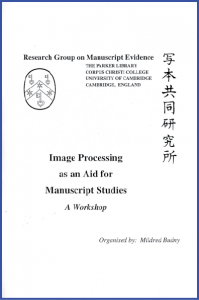 A Visit
A Visit
to the British Library
by the Research Group on Manuscript Evidence
15 December 1993
In preparation for the Workshop
on Image-Processing and Manuscript Studies”
at the Parker Library on 15 January 1994
in the Series of
Research Group Seminars on ‘The Evidence of Manuscripts’
The Parker Library, Corpus Christi College, Cambridge
[First published on our website on 5 September 2016]

© The British Library Board. Cotton MS Claudius A III, folio 8r. Reproduced by permission
A 1-day visit to the British Library in December 1993 prepared for the Research Group’s January 1994 workshop on optical imaging techniques as aids for manuscript studies.
Organised by Mildred Budny and Tony Parker and held at the Parker Library, that approaching workshop on Image-Processing for Manuscript Studies” aimed to consider developments in imaging through photographic and computerised methods, as a means of gathering information and feedback about techniques of image processing, both existing and planned, with a view toward applications, capabilities, limitations, desiderata, and future potential.
Participants at the workshop would include experts in manuscript studies, conservation, photography, imaging aids, computing, radio astronomy, engineering, forensics and medical imaging. The speakers would come from the Research Group on Manuscript Evidence, the University of Cambridge, the British Library, the University of Kentucky, the Questioned Documents Section of the Metropolitan Police Forensics Laboratory, Ipswich Hospital, and Keith & Pelling Ltd. The other participants would come from both near and far.
Meanwhile, there were elements of information to gather and materials to prepare.
Fact-Finding, Demonstrations, and Explorations

Viewing the Front of The British Museum via Postcard.
The Visit took place in the Manuscripts Conservation Studio of the Collection and Preservation Directorate of The British Library. At the time, remember, The British Library (created on 1 July 1972 as a result of the British Library Act 1973) still remained in its “old” building, before the move in 1999 to the new building, specially built for the purpose, on the Euston Road, Number 96. That is, the British Library remained in the same building as The British Museum, out of which it had emerged as an entity of its own. The Department of Western Manuscripts remained in its domicile, in the East Wing of the building (designed in Greek Revival Style by Sir Robert Smirke and completed in 1852), facing Great Russell Street and the Front Entrance. The Manuscripts Conservation Studio occupied quarters in the Basement below.
During the years of her long-term research on manuscripts at The British Library for the Ph.D. (London 1984), Mildred Budny (a founder member and by now Director of the Research Group on Manuscript Evidence) had been a frequent visitor to the Manuscripts Conservation Studio, at Tony Parker’s invitation, to learn about new equipment, new techniques, and new discoveries as part of the conservation work on many forms of materials, manuscript and other. As a result both of such visits and meetings elsewhere, conferences included, it was “natural” to learn, for example, about the Beowulf Digitisation Project (1992–) already as it was beginning to take shape and form.
Here, thanks to that Project (and other developments), you may see, right now, here and now, how the sole surviving medieval copy (partly burnt) of Beowulf begins:
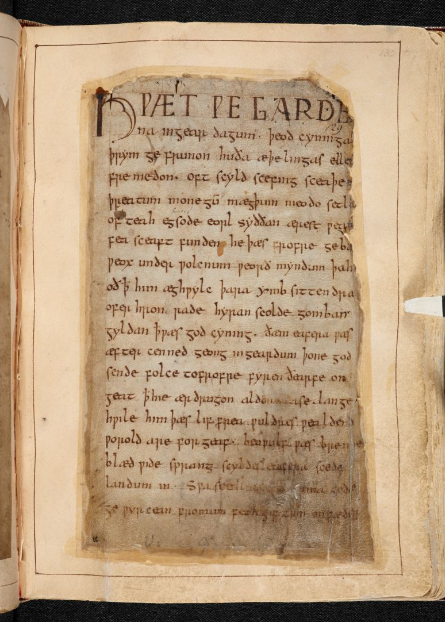
© The British Library Board. Cotton MS Vitellius A XV folio 132r. Reproduced by permission.
On the day, we could inspect the Real Thing, viewed with the relevant equipment, and guided by a founder of the Beowulf Digitisation Project in a formative period. At the January Workshop on “Image-Processing for Manuscript Studies”, Kevin Kiernan also joined the presentations, although that time not in the presence of the manuscript itself, but represented by proxy, and moreover by computer transmission of images via the University of Kentucky to Cambridge. (You may take such representation for granted, nowadays, but we report an earlier stage in the worldwide transformation of the transmission of images of manuscripts, etc . . . )

© The British Library Board. Cotton MS Vitellius A XV folio 140r. Reproduced by permission.
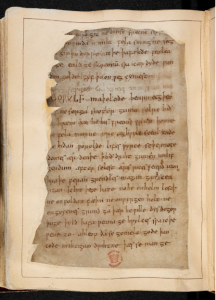
© The British Library Board. Cotton MS Vitellius A XV folio 163v. Reproduced by permission.
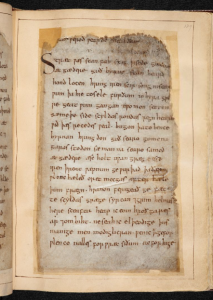
© The British Library Board. Cotton MS Vitellius A XV folio 139r. Reproduced by permission.
*****
Report of the Visit, Now with Illustrations
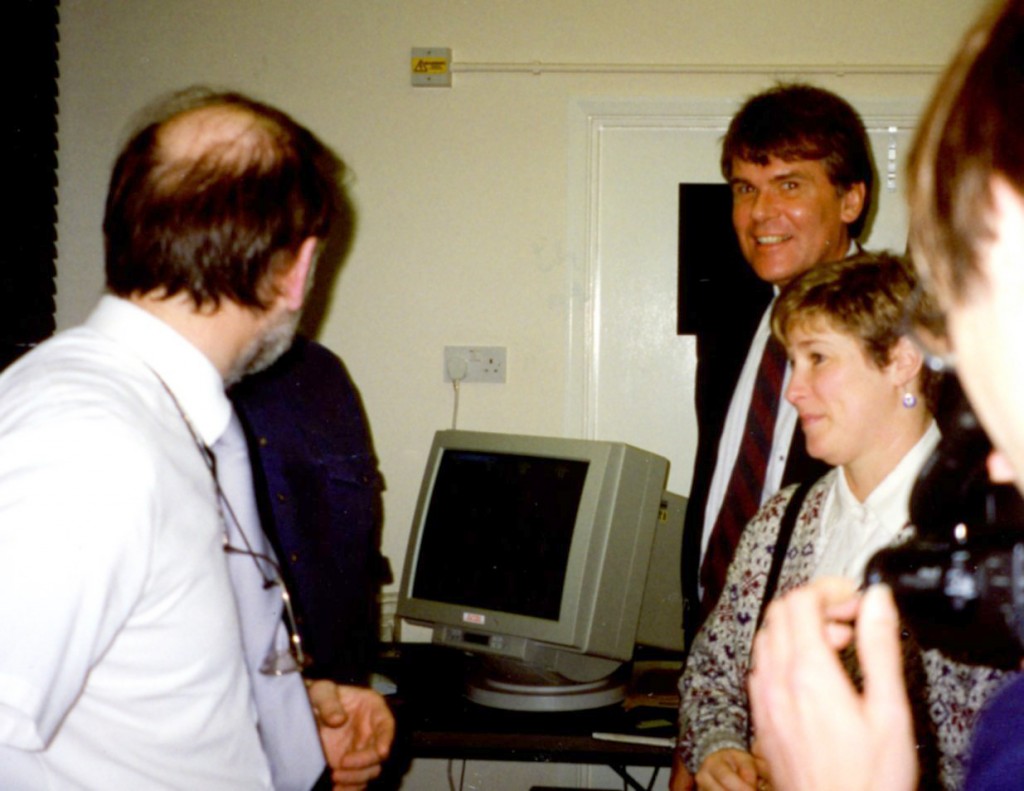
‘Imaging Aids’ on 15 December 1993. Photography © Mildred Budny.
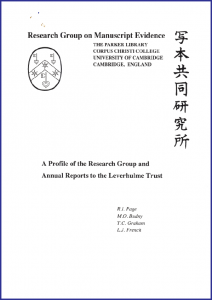 A report of this December Visit appears as an Appendix to the “Preliminary Report” of the 15 January Workshop, printed and circulated as a Booklet after its event. A similar Report for the December Visit to the British Library appears in the Fifth, and Final, Annual Report to the Leverhulme Trust (1993–4) on the 5-year Research Project at The Parker Library on “The Archaeology of Anglo-Saxon Manuscripts” (Leverhulme Trust ref. F665). On the series of Annual Reports, see our Publications.
A report of this December Visit appears as an Appendix to the “Preliminary Report” of the 15 January Workshop, printed and circulated as a Booklet after its event. A similar Report for the December Visit to the British Library appears in the Fifth, and Final, Annual Report to the Leverhulme Trust (1993–4) on the 5-year Research Project at The Parker Library on “The Archaeology of Anglo-Saxon Manuscripts” (Leverhulme Trust ref. F665). On the series of Annual Reports, see our Publications.
We now transcribe the Report here, for you to see both on our website and in our Research Group font Bembino — our own copyright font, designed over more recent years by one of the participants of this Visit. (You may download this font for FREE here.) You may also view the Appendix on its original page in the downloadable Booklet. Here, we add some links and, by permission from The British Library, several images from the relevant manuscripts examined during the Visit.
Read the rest of this entry →
 The extracted and reduced leaf was converted through reuse into part of the cover or wrapper for some volume or other, now unknown. At some point, at least by the year 2016, the part-leaf was removed from that interim position and offered for sale on its own online. It has come to its present owner recently, without record of the provenance of the leaf, or the nature and contents of its former volume, let alone of its original manuscript.
The extracted and reduced leaf was converted through reuse into part of the cover or wrapper for some volume or other, now unknown. At some point, at least by the year 2016, the part-leaf was removed from that interim position and offered for sale on its own online. It has come to its present owner recently, without record of the provenance of the leaf, or the nature and contents of its former volume, let alone of its original manuscript.
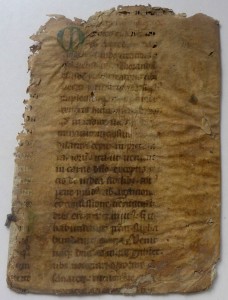









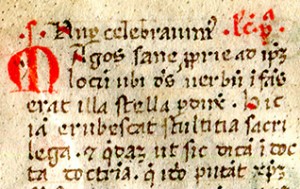
A Leaf from Gregory’s Dialogues Reused for Euthymius
December 24, 2016 in Manuscript Studies, Photographic Exhibition, Uncategorized
A Leaf from Gregory’s Dialogues
Reused for Binding
A Copy of
Euthymius Zigabenus’s On the Psalms
Budny Handlist 3
In our blog on Manuscript Studies (see its Contents List), Mildred Budny (see Her Page) continues to report the results of research for her Illustrated Handlist.
Here, we focus upon a leaf plucked from its 12th-century manuscript and pressed into service, with trimmed edges and mitered folds, as the vellum covering for a binding for a different text of small format. Both texts, primary and secondary in the life of the leaf, concern religious subjects, but they emanate from authors of different dates, locations, and languages in the Latin West and the Orthodox East respectively. The primary text represents a remnant of a text and an author familiar in some other blogposts, which consider the Dialogues, the Sermons or Homilies, and other texts by Pope Gregory the Great (pope from 590 to 694 CE).
Handlist 3, Recto
Handlist 3, Verso
Part of Gregory’s Dialogues, Book III, Chapter 7
(on Andreas, Bishop of Fondi/Fundi):
Sections 2 (Hic namque uenerabilis uir) –
8 (uel quae in conuentu)
Present measurements:
Circa 357 × 237 mm
< written area circa 266 × 133 mm >
Single column of 28 lines
in revived Caroline minuscule
without embellishments
Germany, circa 1175
Reused for some time as the vellum cover for the binding of a copy of
Euthymius Zigabenus‘s Commentary on the Psalms
in Greek or in Latin translation?
(now lost or preserved elsewhere in a location unknown)
For this secondary use, the remnants of a set of titles on the outside of the spine of the cover (the original verso of the reused leaf) remain in place, albeit abraded and fragmented, as both a pasted, inscribed paper label (orientated along the ‘horizontal’ across the spine) and an ink inscription on the reused leaf itself in Capitals (‘vertical’, with the tops of those letters turned toward the ‘front cover’). Another, smaller and fragmentary pasted label with a broad rectangular border stands near the bottom of the broad spine of the cover and partly overlies the ‘vertical’ spine inscription.
Acquired, probably by purchase (according to the Owner’s recollections), in France in the past 15 years or so, but before 2007 when I first saw and began to photograph the leaf. This item and others in the Illustrated Handlist acquired in France at various times and by various means (purchase, gift, or exchange), came from a single source in the Département of Saône-et-Loire, from about 1999 onward. Because the leaf does not carry indications of its original place and time of production, apart from its materials, layout, design, script, orthography, and punctuation, those unknowns must depend upon evaluations of the style of the script, lacking any forms of embellishment, such as decorated initials, which might have provided possibly more closely datable symptoms than the letters “alone”.
Read the rest of this entry →
Tags: 'Fifty Original Leaves from Medieval Manuscripts', Binding History, Bishop Andrew of Fundi, Budny's Illustrated Catalogue, Ege Manuscript 41, Euthymius Zigabenos, Fondi, Gregory the Great, Gregory's Dialogues, manuscript fragments, Manuscript Fragments Reused in Bindings, Manuscript studies, Psalter Commentary, Saki, Temple of Apollo
No Comments »